
By David Searle*
 One of the most important aspects of running a business is to ensure there is adequate cash flow to meet all short-term obligations.
One of the most important aspects of running a business is to ensure there is adequate cash flow to meet all short-term obligations.
The survival of your business will depend on this.
Referred to as working capital management, this is all about setting up strategies to ensure there is enough cash in the business to operate on a day-to-day basis without facing a cash crisis.
Working capital in business is made up of these core components:
• stock management
• payment of suppliers (creditor payments)
• work in progress
• collection of cash from customers (debtor collection).
Often referred to as “the working capital cycle”, this is really about the length of time from using your cash to purchase stock (or perhaps getting it from a supplier on credit terms), and using the stock, possibly for a manufacturing purpose (creating part of the cycle called “work in progress”), to securing the sale and receiving the cash.
Here is a diagram of the working capital cycle:

Between each stage of the working capital cycle, there is a time delay.
Some businesses require a substantial length of time to make and sell the product. In these enterprises, a large amount of working capital will be needed to survive.
Other businesses may receive their cash very quickly after paying out for stock - perhaps even before they have paid their bills. Service businesses will not need to pay out cash for stock and therefore will need less working capital.
The key to successful cash management is carefully monitoring all the steps in the working capital cycle. The quicker the cycle turns, the faster you have converted your trading operations back into available cash, which means you will have increased the liquidity in your business and will be less reliant on cash or extended terms from external stakeholders such as banks, customers and suppliers.
The following sections provide information on some of the ways you can make the working capital cycle move more quickly and improve the cash flow in your business.
Working capital is the short-term capital that works for the business. This includes stock, work in progress, payments to suppliers and receipts from customers. By working your cycle more efficiently, you have cash more readily available to use in other parts of the business.
Managing stock
Stock management is about having the right level of stock to satisfy the needs of your customers and managing the stock to identify excess or aged stock.
Of course, stock has to be funded, either from existing cash in the business or from borrowings, so it is important the stock levels are managed so they use up the minimum financial resources necessary.
This does not necessarily mean keeping low levels of stock, but rather ensuring that stock is held for the shortest possible time, which means it will be converted into cash quickly. (Too little stock can impact sales, so the key is to find the appropriate level, which will change over time.)
However, maintaining stock comes with a cost. It is estimated that holding stock can cost anything between 10 and 30 per cent of the value of the stock. This includes storage, insurance, keeping accurate tracking records and proper controls to avoid theft.
HINT
Setting up good stock control procedures will ensure cash is not tied up in holding unnecessary stock.
Efficient stock control involves three elements:
• stock review
• buying policy
• operational issues.
The following checklist will help you determine what measures for stock control you may need or can use to improve your existing procedures.


TIPS FOR IMPROVING STOCK CONTROL
• For fast-moving stock, negotiate with suppliers for delivery when required (called JIT, for just in time), eliminating the need to hold a large inventory to meet customer demand.
• For aged and excess stock, either sell at whatever price it takes to move it, or donate it to a charity or community group. (Don’t forget to advertise that you have made a donation!)
• Keep accurate stock records and regularly (at least once a year) match the records to a physical count. If there are large variances between the records and the physical count, do the count more regularly until the anomalies are identified and corrected.
• Understand your stock - for example, which items move quickly, which items contribute the highest gross margin and which ones are seasonal. This will help you determine how much of each line of stock to keep on hand and when reordering is required.
• Use your financial system to track stock items. This will help with both:
- automating reorder requirements
- matching different stock items to sales and easily identifying high-margin sales.
• Keeping good control over your stock holdings will ensure you keep aged and excess stocks to a minimum and reduce the risk of theft, while still having adequate stock levels to meet your customers’ needs.
Using numbers to manage stock
Days inventory ratio
This ratio reveals how well your stock is being managed. It is important because it will indicate how quickly stock is being replaced, and the more times inventory can be ‘turned’ (replaced) in a given operating cycle, the greater the profit.
Days inventory ratio is calculated as follows:

This calculation shows that, on average, Joe holds his stock for 36.5 days.
Stock turn
This calculation shows the effectiveness of your planning of stock holdings. A low stock-turn rate will show you are not moving stock, which could lead to excess or aged stock and, of course, higher holding costs. A high stock-turn rate could indicate you run the risk of not having adequate stock on hand to supply customers’ needs.
Stock turn is calculated as follows:

This calculation shows that Joe turns his stock over, on average, 10 times per year.
The days inventory and stock-turn calculations should be compared with industry averages to provide the most useful information. Comparing these measures regularly with previous periods in your business will also provide information on the effectiveness of stock management within your business.
Managing payments to suppliers
The payment of suppliers will impact your cash flow. Often, start-up businesses will have to pay suppliers in cash on delivery of goods or services because they do not have a trading history. The supplier will not be prepared to provide the goods or services on credit because they cannot be sure the business will be profitable or even still operating in the future.
Once your business is up and running, there is likely to be some scope to negotiate with your suppliers so that you can pay on credit and free up cash flow.
Making full use of your payment terms with your supplier is effectively an interest-free loan. Therefore, it is important to manage your suppliers and the payments to them in the same way as you manage the other key components of the working capital cycle.
Effective management of suppliers and the payments to them consists of three key elements:
• supplier selection
• payment terms
• managing relationships.
HINT
Setting up good management procedures will ensure you get the most out of your relationship with suppliers.
The following checklist will help you review what procedures you may need to improve your existing supplier procedures:


TIPS FOR IMPROVING SUPPLIER PAYMENTS• Extend payment terms. Lengthening the payment from 30 to 45 days may help to smooth out fluctuations in cash flows.• Ask larger companies (such as utilities) whether they will accept quarterly payments, which can help in forecasting cash flow requirements.
• Specify that payment terms commence from complete delivery, as opposed to part delivery. This should also include goods or services that have not been provided as agreed.
• Where goods are returned, either:
- a new invoice should be raised, and this is the initiation of the payment terms, or
- disputed invoices are held over until a credit note is received.• Initiate a structured payment run, usually once a month (on the last day of the month) and stick to it.
• Ensure your systems have good controls so suppliers are not:
- paid early. Where financial systems are used, ensure payment date is automated from approved supplier details and no change to the automated date is possible without authorisation.
- overpaid. All received goods must be checked against purchase orders and the totals on invoices checked.
- paid twice. Pay only on statement.• Continually review supplier contracts for opportunities such as:
- improved pricing
- effective discounting
- improved delivery. (You will not need to order so early and therefore will be able to defer payment.)
Using numbers to manage payments to suppliers
Days creditors ratio
This ratio indicates how well accounts payable (payments to suppliers) is being managed. If these payments are being paid, on average, before agreed payment terms, cash flow may be impacted. If payments to suppliers are excessively slow, there is a possibility relationships with suppliers will be damaged.
The days creditors ratio is calculated as follows:

Note: 'Accounts payable' is the amount owed to your suppliers at the time of the calculation.

This calculation shows that Joe pays his suppliers on average every 29 days.
Managing work in progress
Work in progress is where an order has been taken from the customer and you are in the process of “working” to complete the order. Of course, in most circumstances there will be many orders in progress, so you will need good management systems in place for efficient execution of customer orders.
Work in progress is often thought to be relevant only in manufacturing business; however, some retail and service businesses will also have a form of work in progress - from the time of the customer order to delivery.
Managing work in progress is important because the quicker the job can be completed, the earlier the invoice can be raised and the cash received for the job.
HINT
The key to managing work in progress is a good record-keeping system.
The following checklist will assist you in comparing your work-in-progress procedures and may help to identify some improvements.

TIPS FOR IMPROVING WORK IN PROGRESS
• Order stock only when you are ready to use it, effectively reducing the number of days held (and hence paid) before production begins.
• Identify any bottlenecks in the production process and look for improvements.
• Look at the process, including the physical layout of goods, and identify possible improvements to speed up the movement through the work-in- progress stage.
• Before accepting the order, ensure you know how much stock you need to have on hand to complete the order. Delay in receiving goods is delay in preparing the sale.
• Review work-in-progress procedures annually to identify possible procedures or technology that could improve the process.
• Where specific materials are required for the customer order (such as fabric for covering a couch), include in your order agreement that the customer pays a deposit up front before the order is commenced.
Managing debtors
Sales income is a cash flow driver of all businesses and converting the sale into cash is one of the most important processes in any business.
Where sales are offered on credit, financial systems will refer to the amount outstanding as a “debtor”. Managing the payments due from debtors can consume a lot of unnecessary effort if proper controls and procedures are not put in place at the outset.
Your customers are your key to business success; however, until you receive the cash for the sale, effectively you have given a donation to your customers! So it is important to manage all outstanding payments from your customers and ensure you have good procedures in place to encourage your customers to pay the correct amount on time.
Efficient debtor collection procedures include:
• credit controls
• payment terms
• managing customer relationships.
The following checklist can be used to compare your existing procedures for collecting outstanding amounts from your customers and help identify possible improvements:


TIPS FOR IMPROVING DEBTOR COLLECTIONS
• Send out invoices as soon as work is completed, not at the end of the week or month.
• Provide incentives to pay early (for example, a discount), but take account of the impact on profit margin.
• Make it easy to pay via direct credit arrangements, EFTPOS or credit card.
• Where commission is paid to sales staff, pay it on amounts collected, rather than on total sales amounts booked.
• Run regular reports to identify when payments are due (aged debtors report).
• Identify slow-paying customers and make contact early to discuss any problems (such as faulty goods, inadequate service or inability to pay).
• Monitor and regularly contact non-paying customers.
• Make arrangements for non-paying customers (set up payment plan to clear the debt).
• Implement a policy to stop supplying a customer until all debts are cleared.
• Send letters of demand for long-outstanding debts.
• If necessary, use a professional debt collector.
• Remember, a good customer is one that pays. If you are not collecting the cash from your customer, then your organisation is funding your customer’s business as well as your own.
Using numbers to manage payments from customers
Days debtors ratio
This ratio indicates how well the cash from customers is being collected. Referred to as accounts receivable in accounting terms, this is the total outstanding amount owed to you by your customers.
If these receivables are not collected reasonably in accordance with their terms, you should rethink the collection policy.
If receivables are excessively slow in being converted to cash, the liquidity of your business will be severely affected.
The days debtors ratio is calculated as follows:

This calculation shows that, on average, Joe collects from his debtors every 126 days.
Working capital cycle - cash conversion rate
The overall number of days to convert your trade from the cash outflow at the beginning of the working capital cycle to cash received at the end of the cycle can be calculated by the cash conversion rate.
HINT
Calculate the cash conversion rate and compare this with the standards within your industry. Using each of the tips in the sections above, identify which areas of the cycle are problematic and prepare an action plan to improve the cash conversion rate.

Cash conversion rate calculation
The cash conversion rate is calculated as:

This calculation shows that for Joe’s Motorbike Tyres the working capital cycle takes 133.6 days from the start of the transaction to when the transaction is completed and converted back to cash.
TIP
Regularly calculate your cash conversion rate and implement improvement to your working capital to free up idle cash that is not being used within the business. This will reduce the need to borrow additional funds to support the operations of the business, decrease reliance on funds from financiers and reduce any interest expense incurred.
------------------------------------------------------------------------------------------------------
The full Guide is available in the .pdf attachment, or here »
------------------------------------------------------------------------------------------------------
David Searle is an Assurance Services Partner with Staples Rodway and is the immediate past president of CPA Australia New Zealand Division. You can contact them directly here »
You can read the Introduction to this series here » The related Glossary is an important resource. And readers are encouraged to read this page first »
Chapter 1 is about Understanding financial statements and you can read it here »
Chapter 2 is about Assessing your busines's financial health and you can read it here »
Chapter 3 is about the Importance of Budgeting and you can read it here »
Chapter 4 is about the Maintaining Profitability and you can read it here »
Chapter 6 is about Managing Cashflow and will follow next week.
We welcome your comments below. If you are not already registered, please register to comment.
Remember we welcome robust, respectful and insightful debate. We don't welcome abusive or defamatory comments and will de-register those repeatedly making such comments. Our current comment policy is here.